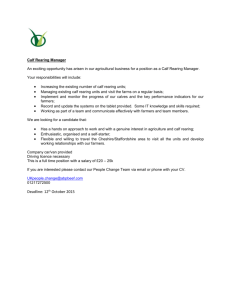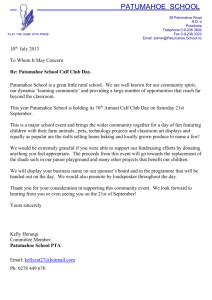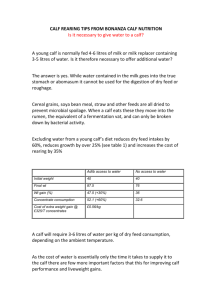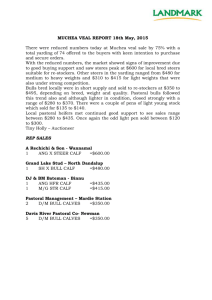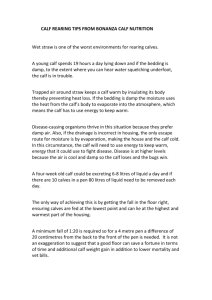Calf Rules
advertisement
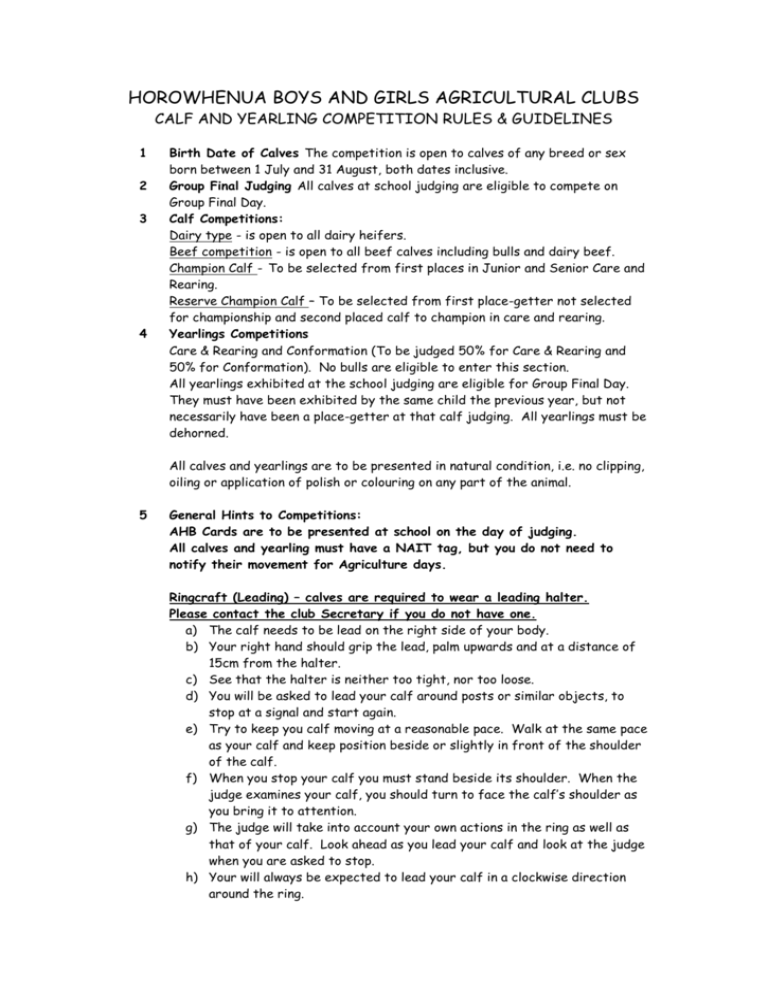
HOROWHENUA BOYS AND GIRLS AGRICULTURAL CLUBS CALF AND YEARLING COMPETITION RULES & GUIDELINES 1 2 3 4 Birth Date of Calves The competition is open to calves of any breed or sex born between 1 July and 31 August, both dates inclusive. Group Final Judging All calves at school judging are eligible to compete on Group Final Day. Calf Competitions: Dairy type - is open to all dairy heifers. Beef competition - is open to all beef calves including bulls and dairy beef. Champion Calf - To be selected from first places in Junior and Senior Care and Rearing. Reserve Champion Calf – To be selected from first place-getter not selected for championship and second placed calf to champion in care and rearing. Yearlings Competitions Care & Rearing and Conformation (To be judged 50% for Care & Rearing and 50% for Conformation). No bulls are eligible to enter this section. All yearlings exhibited at the school judging are eligible for Group Final Day. They must have been exhibited by the same child the previous year, but not necessarily have been a place-getter at that calf judging. All yearlings must be dehorned. All calves and yearlings are to be presented in natural condition, i.e. no clipping, oiling or application of polish or colouring on any part of the animal. 5 General Hints to Competitions: AHB Cards are to be presented at school on the day of judging. All calves and yearling must have a NAIT tag, but you do not need to notify their movement for Agriculture days. Ringcraft (Leading) – calves are required to wear a leading halter. Please contact the club Secretary if you do not have one. a) The calf needs to be lead on the right side of your body. b) Your right hand should grip the lead, palm upwards and at a distance of 15cm from the halter. c) See that the halter is neither too tight, nor too loose. d) You will be asked to lead your calf around posts or similar objects, to stop at a signal and start again. e) Try to keep you calf moving at a reasonable pace. Walk at the same pace as your calf and keep position beside or slightly in front of the shoulder of the calf. f) When you stop your calf you must stand beside its shoulder. When the judge examines your calf, you should turn to face the calf’s shoulder as you bring it to attention. g) The judge will take into account your own actions in the ring as well as that of your calf. Look ahead as you lead your calf and look at the judge when you are asked to stop. h) Your will always be expected to lead your calf in a clockwise direction around the ring. i) The a) b) c) d) e) Your right hand on the lead close to the chin is how you steer the calf. It is also how you make it move and stop. following actions may be penalised. Releasing the grip on the lead. Touching the calf with your hand during leading. Slapping the calf with the hand or lead. Jerking on the halter. Elbowing the calf or pushing it with your hip. Care a) b) c) and Rearing: Competitors must groom the animals themselves. Healthy appearance and clean skin – evidence of correct feeding. Absence of skin parasites. Well groomed – head to tail. Evidence of – Correct brushing with a soft brush; no skin abrasions The use of a cover will assist in the removal of old hair. This will also keep the calf warm and dry. You can also use a rubber mitt or similar equipment for stubborn old hair. d) Clean halter, hooves, tail, ears, mouth and nostrils. 6 Footwear – Protective footwear be worn in all animal judging. Gumboots not recommended. BADGE AWARD SCHEME The purpose of the scheme is to foster the continuing interest in the club’s activities and to give some tangible recognition to those who have participated in the club’s competitions for many years, often without success. Conditions for the award are as follows: Satisfactory completion of four projects over a minimum of three years. In only one of those years can two projects be completed for the badge. Projects which qualify are calf, yearling, lamb or kid rearing projects and the garden competitions. No project will count if not completed to a satisfactory standard. That the final project be accompanied by a full written record of the rearing of the animal, or of the attention given to the garden. Record books are essential in the garden competition and we encourage this with the animal projects as well. If your school does not have one of their own, this can be provided by the club. This is only essential when children are finishing the badge award scheme. Schools are to judge the record books from all animal sections and send the top three to Group Final Day for judging. Calf Judging rings at schools should be sufficiently large to allow the pegs to be 10m apart. Below is the Calf Leading Pattern used in the Ringcraft test. The top pattern is the senior test. The bottom is the junior test. PLEASE REMEMBER THAT IF YOU ENTER GROUP FINAL DAY AND YOU ARE YEAR 4 YOU WILL BE EXPECTED TO COMPLETE THE SENIOR TEST. SO IT IS A GOOD IDEA TO PRACTICE BOTH.

